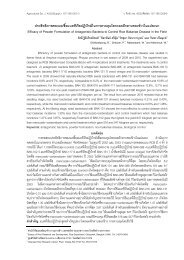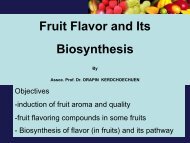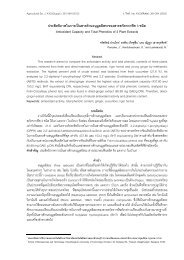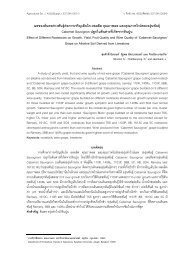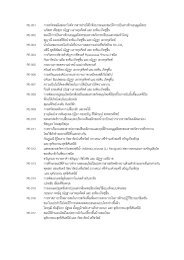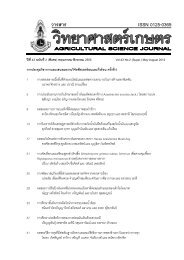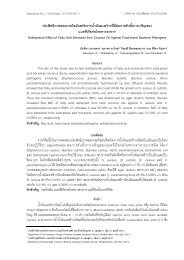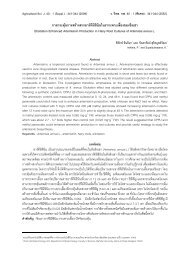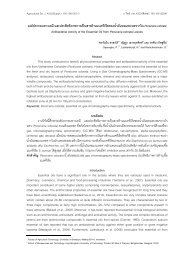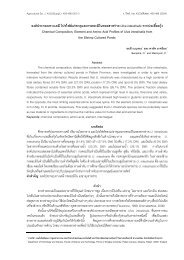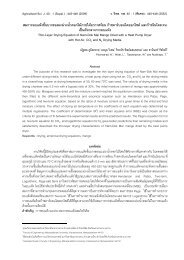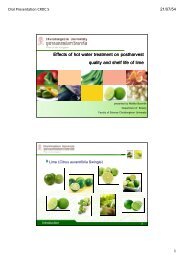Changes of Volatile Compounds and Physicochemical ... - CRDC
Changes of Volatile Compounds and Physicochemical ... - CRDC
Changes of Volatile Compounds and Physicochemical ... - CRDC
Create successful ePaper yourself
Turn your PDF publications into a flip-book with our unique Google optimized e-Paper software.
Agricultural Sci. J. 42(2)(Suppl.): 109-112 (2011) ว. วิทย์. กษ. 42(2)(พิเศษ): 109-112 (2554)<br />
การเปลี ยนแปลงสารหอมระเหยและคุณภาพทางเคมี กายภาพของส้มโอตัดแต่งระหว่างการเก็บรักษา<br />
<strong>Changes</strong> <strong>of</strong> <strong>Volatile</strong> <strong>Compounds</strong> <strong>and</strong> <strong>Physicochemical</strong> Qualities <strong>of</strong> Fresh Cut Pomelo During Storage<br />
อรัญญา นิพนธ์ศักดิ 1 ณัฎฐา เลาหกุลจิตต์1 และ อรพิน เกิดชูชื น 1<br />
Niponsak, A. 1 , Laohakunjit, N. 1 <strong>and</strong> Kerdchoechuen, O. 1<br />
Abstract<br />
<strong>Volatile</strong> compounds <strong>and</strong> physicochemical qualities <strong>of</strong> fresh cut pomelo are important for consumer<br />
acceptance. This research was to evaluate the volatile compounds changes <strong>and</strong> physicochemical qualities;<br />
volatile compounds, pH, titratable acidity, % total soluble solid ( o Brix), sugar content, fruit colour <strong>and</strong> firmness<br />
<strong>of</strong> fresh cut pomelo cv. Khao yai during storage under ambient conditions (25 o C+3). Three main volatile compounds<br />
were found in fresh cut pomelo during storage. Although cyclopentyl-4-ethylbenzoate was increased<br />
during storage, δ- cadinene <strong>and</strong> β caryophyllene were increased at the first stage <strong>of</strong> three days <strong>and</strong> decreased<br />
at the end <strong>of</strong> four days storage. Fresh cut pomelos were more lighten (L*) than the control but a* (redness)<br />
was decreased while b* (yellowness), hue <strong>and</strong> chroma were stable during storage. Moreover, fruit firmness,<br />
pH <strong>and</strong> sucrose content slowly decreased during the storage conditions but %titratable acidity, fructose<br />
<strong>and</strong> glucose content slightly increased.<br />
Keywords: pomelo, volatile compounds, physicochemical qualities, storage<br />
บทคัดย่อ<br />
สารหอมระเหยและคุณภาพทางเคมี-กายภาพของส้มโอตัดแต่งมีความสําคัญต่อการเลือกซื อของผู ้บริโภค ดังนั น<br />
งานวิจัยนี จึงศึกษาการเปลียนแปลงของสารหอมระเหยและคุณภาพทางเคมี-กายภาพของส้มโอตัดแต่งพันธุ ์ขาวใหญ่ระหว่าง<br />
การเก็บรักษาทีอุณหภูมิห้อง (25 o C+3) คุณสมบัติทางเคมีได้แก่ สารหอมระเหย pH ความเป็ นกรด ปริมาณของแข็งทั งหมด<br />
( o Brix) ปริมาณและชนิดนํ าตาล ส่วนคุณสมบัติทางกายภาพ ได้แก่ ค่าสี และ ค่าความแน่นเนื อ พบการเปลียนแปลงของสาร<br />
หอมระเหยหลัก 3 ชนิดในส้มโอตัดแต่งสด โดย cyclopentyl-4-ethylbenzoate มีปริมาณเพิมขึ นในระหว่างการเก็บ ขณะที<br />
δ- cadinene และ β-caryophyllene เพิมขึ นวันที 1 ถึงวันที 3 และลดลงเมือสิ นสุดระยะเวลาการเก็บในวันที 4 ในระหว่าง<br />
การเก็บรักษา ค่าความสว่างของส้มโอตัดแต่งเพิมขึ น ค่าความเป็ นสีแดงลดลง ส่วนค่าความเป็ นสีเหลือง hue angle และ<br />
chroma ไม่เปลียนแปลง ค่าความแน่นเนื อ pH และปริมาณซูโครสค่อยๆ ลดลง แต่ค่าความเป็ นกรด ปริมาณนํ าตาลฟรุกโตส<br />
และกลูโคสเพิมขึ น<br />
คําสําคัญ: ส้มโอ สารหอมระเหย คุณภาพทางเคมี-กายภาพ การเก็บรักษา<br />
Introduction<br />
Pomelo is an economically important fruit in Thail<strong>and</strong>. The pomelo is a non-climacteric fruit which contains<br />
rich <strong>of</strong> nutritions such as vitamin C, potassium, phosphorus, folic acid, citric acid, etc. (Igual et al., 2010).<br />
The flavour <strong>of</strong> pomelo is mild, not sour like a grapefruit <strong>and</strong> sweet as an orange but pomelo is difficultly eaten<br />
<strong>and</strong> difficultly observed senescence in whole fruits. Thus, minimally process or fresh cut pomelo is developed<br />
but storage period <strong>of</strong> pomelo is not detected. Fruit storage involves many physicochemical qualities changes<br />
which influence on the consumer satisfaction. Flavour studies in different fruit samples have been <strong>of</strong> increasing<br />
interests due to their relationship with quality. As a result, there are many researches <strong>of</strong> volatile compound<br />
changes <strong>of</strong> whole fruit during storage such as apricot (Gonzalez et al., 2009), pineapple (Umano et al., 1992)<br />
<strong>and</strong> pomelo (Phaungsombut et al., 2008). Although previous work on the quality <strong>of</strong> pomelo in the whole fruit<br />
had been studied, the monitoring <strong>of</strong> chemical <strong>and</strong> physical qualities in fresh cut pomelo during storage has<br />
1<br />
คณะทรัพยากรชีวภาพและเทคโนโลยี มหาวิทยาลัยเทคโนโลยีพระจอมเกล้าธนบุรี 49 ซ.เทียนทะเล 25 แขวงท่าข้าม เขตบางขุนเทียน กรุงเทพ 10150<br />
1<br />
School <strong>of</strong> Bioresources <strong>and</strong> Technology, King Mongkut’s University <strong>of</strong> Technology Thonburi, 49 Soi Tientalay 25, Thakam, Bangkhuntein, Bangkok 10150
110 ปี ที 42 ฉบับที 2 (พิเศษ) พฤษภาคม - สิงหาคม 2554 ว. วิทยาศาสตร์เกษตร<br />
lack <strong>of</strong> information. The objective <strong>of</strong> this research was to report the volatile compounds <strong>and</strong> physicochemical<br />
changes in pomelo cv.Khao yai during storage at ambient conditions.<br />
Materials <strong>and</strong> Methods<br />
Plant materials preparation: Pomelo (Citrus maxima) cv. Khao yai was harvested at 100% maturity <strong>and</strong> transported<br />
from the orchard to the laboratory. Fruits were selected for uniformity in size (1.6 -1.9 kg) <strong>and</strong> colour. After<br />
that, fresh pomelo pulps were taken out from the fruit. The pulps were placed on polystyrene trays <strong>and</strong> wrapped<br />
with a commercially film. Fruits were packaged <strong>and</strong> kept at an ambient temperature <strong>of</strong> 25 o C + 3. <strong>Volatile</strong> compound,<br />
colour, fruit firmness, pH, %titratable acidity, total soluble solid <strong>and</strong> sugar content were measured every<br />
day <strong>and</strong> all analyses were performed in three replicates. Analysis <strong>of</strong> variance (ANOVA) <strong>and</strong> Duncan’s multiple<br />
range test (DMRT) were performed using the SAS Program Version 6.0 (SAS Institute, 1997,USA)<br />
Isolation <strong>of</strong> volatile compounds using headspace-solid-phase microextraction gas chromatography (HS-SPME-<br />
GC-MS): A 50/30µm DVB/CAR/PDMS fiber was used in this study. Five milliliters <strong>of</strong> pomelo juice were transferred<br />
into a 30 ml vial. Juice samples were placed in a vial heater at 40 o C 10 min. Sampling time was 45 min<br />
at 40 o C. Desorption temperature at the GC injection port was 220 o C for 5 min. Juice sample was analyzed using<br />
7890A GC-MS(DB-WAX column, 30m x 0.25mm x 0.25µm) <strong>and</strong> the temperature program was: 40 o C, then<br />
40 o C to 240 o C at rate 4 o C min -1 , <strong>and</strong> held at 240 o C for 5 min. The splitless was applied. Mass spectra were<br />
collected at a rate <strong>of</strong> 30 spectra/s over a range <strong>of</strong> m/z 33–500. The ionization energy was 70 eV. Data was<br />
identified according to NIST v2.0 library <strong>and</strong> Wiley. <strong>Compounds</strong> were then confirmed by GC retention time (RT)<br />
<strong>and</strong> MS spectra. The RTs from a series <strong>of</strong> aliphatic alkanes (C 8 –C 20 ) were used to calculate retention indices<br />
(RIs) for all identified compounds.<br />
Colour assessment <strong>and</strong> Fruit firmness: The colour change <strong>of</strong> pomelo pulp in ambient conditions was determined<br />
by a Hunter Lab Colorimeter. Fruit pulps colour was recorded using the CIE-L*, a*, b*, hue angle <strong>and</strong><br />
chroma values. Fruit firmness <strong>of</strong> fruit was measured by Texture analyzer, fitted with a 10 mm cylindrical probe<br />
to the probe carrier. The test was carried out at the probe speed <strong>of</strong> 1 mm/s to compress the fruit for 3 mm from<br />
the contact point. A 250 N load cell was used. The force was recorded in kilogramforce.<br />
pH <strong>and</strong> titratable acidity: Pomelo pulps were squeezed to pomelo juice. The pH <strong>of</strong> pomelo juice was measured<br />
using an electrode pH meter. After pH determination, the juice was added by some drops <strong>of</strong> phenolphtaleine<br />
as indicator solution <strong>and</strong> titrated against 0.1N NaOH to end point <strong>of</strong> pH 8.1. The juice acidity was expressed as<br />
gram <strong>of</strong> citric acid (g citric acid/1 g fresh weight).<br />
Total soluble solid: Pomelo pulps were squeezed to pomelo juice. Total soluble solid <strong>of</strong> samples were measured<br />
using a h<strong>and</strong> refractrometer. Total soluble solid determination to give o Brix at 25 o C.<br />
Determination <strong>of</strong> sugars content: The fruit juice (7 ml) was filtered through filter paper whatman#1 by vacuum<br />
pump, <strong>and</strong> then centrifuged at 6,000 x g for 20 min. Supernatant was filtered through a 0.45-µm Millipore filter<br />
<strong>and</strong> frozen at -18 o C until sugars before analysis. Sugar content (glucose, fructose, sucrose) was analyzed by<br />
HPLC following method from Kelebek (2010) with the column <strong>of</strong> LiChrospher® 100 NH 2 <strong>and</strong> RI detector was<br />
used for sugar analysis. The mobile phase was 86% acetronitrile/de-ionized water with the flow rate <strong>of</strong> 1.5 ml<br />
min -1 . Sugars content in each sample were identified <strong>and</strong> quantified by external st<strong>and</strong>ard method using a<br />
commercial st<strong>and</strong>ard <strong>of</strong> sucrose, glucose, <strong>and</strong> fructose.<br />
Results <strong>and</strong> Discussion<br />
In order to evaluate aroma changes under ambient conditions, Table 1 shows 34 volatile compounds<br />
were identified in pomelo which odor description gave wood, citrus, herb, green <strong>and</strong> floral odor description during<br />
storage. The major volatile compounds in fresh pomelo were 3 compounds, cyclopentyl-4-ethylbenzoate<br />
increased during storage, δ-cadinene <strong>and</strong> β-caryophyllene were increased at three days <strong>and</strong> decreased at the
ว. วิทยาศาสตร์เกษตร ปี ที 42 ฉบับที 2 (พิเศษ) พฤษภาคม - สิงหาคม 2554 111<br />
end <strong>of</strong> storage. Amounts <strong>of</strong> other terpene compounds, such as α-ylangene, germacrene D <strong>and</strong> aromadendrene<br />
were rather different from the other citrus fruit varieties. When storage pomelo at room temperature for four days,<br />
it found that volatile compounds, which gave wood, citrus, herb <strong>and</strong> floral odor, were decreased. While volatile<br />
compounds, gave musty, green, <strong>and</strong> earthy odor, were increased. The most other volatile compounds increased<br />
during storage because harvested fruits are living tissues <strong>and</strong> continue to respire <strong>and</strong> loss water in transpiration.<br />
PVC film wrap has good gas permetration rate so the living tissue <strong>of</strong> pomelo can use oxygen to produce<br />
terpenoid by mevalonic acid pathway (Perez et al., 1992) or alcohol, aldehyde, acid <strong>and</strong> ester produce by<br />
oxidation reduction pathway (Umano et al., 1992). But some volatile compound decreased, it may be use degradation<br />
pathway. When storage <strong>of</strong> pomelo at room temperature, fruit pulps were more lighten (L*) than the day 1<br />
as same hue angle, a* was decreased but b* <strong>and</strong> chroma were not changed (Table 2). Similar trend was also<br />
reported by Singh <strong>and</strong> Reddy (2006). Fruit firmness <strong>of</strong> fresh cut pomelo was diminished significantly under<br />
ambient at the end <strong>of</strong> 4 days <strong>of</strong> storage might be due to the action <strong>of</strong> pectic enzymes <strong>and</strong> weight loss during fruit<br />
transpiration. The trend is in agreement with the results reported by Muramatsu et al. (1996). pH generally decreased<br />
but acidity increased with storage period under ambient temperature (Table 3). However, total soluble<br />
solid was not changed under ambient storage. Fructose <strong>and</strong> glucose slightly increased in the 4 days <strong>of</strong> storage.<br />
The sucrose reduced in pomelo stored under ambient might be attributed to the change in sucrose to fructose<br />
<strong>and</strong> glucose due to the monosaccharides being used in the respiration process during storage. The trend in<br />
sucrose reduced <strong>of</strong> pomelo with storage period was in agreement with Perez et al. (1992).<br />
Summary<br />
This study demonstrates that the volatile compounds <strong>and</strong> physicochemical qualities <strong>of</strong> fresh cut<br />
pomelo changes can use for indicating the quality <strong>and</strong> storage period <strong>of</strong> fruit. Fresh cut pomelo has shelf life<br />
for 3 days at 25 o C. After 3 days <strong>of</strong> storage, pomelo pulps have 6-methyl-5-hepten-2-ol, 3-methylpentanol,<br />
1-octen-3-ol <strong>and</strong> heptanol which they gave musty odor description, <strong>and</strong> it is consistent with sensory evaluation<br />
by fifteen panelists (data not show), colour, texture <strong>and</strong> chemical quality was changed. The data <strong>of</strong> this study<br />
obtained can be used for decision <strong>of</strong> consumer.<br />
Acknowledgements<br />
This research was supported by a grant from The Royal Golden Jubilee Ph.D Program.<br />
Literature cited<br />
Gonzalez-Aguero, M., Troncoso, S., Gudenschwager, O., Campos-Vargas, R., Moya-Leon, M.A. <strong>and</strong> Defilippi,<br />
B.G., 2009, Differential Expression Levels <strong>of</strong> Aroma-Related Genes During Ripening <strong>of</strong> Apricot (Prunus<br />
armeniaca L.), Plant Physiology <strong>and</strong> Biochemistry, 47: 435–440.<br />
Igual, M., Martinez, E.G., Camacho, M.M. <strong>and</strong> Navarrete, N. M., 2010, Effect <strong>of</strong> Thermal Treatment <strong>and</strong> Storage on<br />
the Stability <strong>of</strong> Organic acids <strong>and</strong> the Functional value <strong>of</strong> Grapefruit juice, Food Chemistry, 118: 291–299.<br />
Kelebek, H., 2010, Sugars, Organic acids, Phenolic Compositions <strong>and</strong> Antioxidant Activity <strong>of</strong> Grapefruit (Citrus<br />
paradisi) Cultivars grown in Turkey, Industrial Crops <strong>and</strong> Products, 32: 269–274.<br />
Muramatsu, N., Kiyohide, K. <strong>and</strong> Tatsushi, O., 1996, Relationship between Texture <strong>and</strong> Cell wall Polysaccharides<br />
<strong>of</strong> Fruit Flesh in Various Species <strong>of</strong> Citrus, Horticulture Science, 31(1): 114–116.<br />
Perez, A.G., Rios, J.J., Sanz, C. <strong>and</strong> Olias, J.M., 1992, Aroma Components <strong>and</strong> Free Amino Acids in Strawberry<br />
Variety Ch<strong>and</strong>ler During Ripening, Journal <strong>of</strong> Agricultural <strong>and</strong> Food Chemistry, 40: 2232-2235.<br />
Phaungsombut, A., Pathaveerat, S. <strong>and</strong> Terdwongworaku, A., 2008, Maturity Assessment <strong>of</strong> Pomelo Based on<br />
Impact Method, Agricultural Science Journal, 39(3)(Suppl.): 27-30.<br />
Singh, K.K. <strong>and</strong> Reddy, B.S., 2006, Post-Harvest Physico-Mechanical Properties <strong>of</strong> Orange peel <strong>and</strong> Fruit,<br />
Journal <strong>of</strong> Food Engineering, 73: 112–120.
112 110 ปี ที 42 ฉบับที 2 (พิเศษ) พฤษภาคม - สิงหาคม 2554 ว. วิทยาศาสตร์เกษตร<br />
Umano, K., Hagi, Y., Nakahara, K., Shoji, A. <strong>and</strong> Shibamoto, T., 1992, <strong>Volatile</strong> Constituents <strong>of</strong> Green <strong>and</strong> Ripened<br />
Pineapple (Ananas comosus [L.] Merr.), Journal <strong>of</strong> Agricultural <strong>and</strong> Food Chemistry, 40: 599-603.<br />
Table 1 <strong>Volatile</strong> compound in pomelo storage at ambient temperature (25 o C +3)<br />
<strong>Volatile</strong> compounds RI % Relative peak area Odor description*<br />
Day 1 Day 2 Day 3 Day 4<br />
α-phell<strong>and</strong>rene 1210 0.58 0.46 0.37 0.21 citrus, green<br />
α-limonene 1244 0.53 1.40 1.39 1.75 citrus, mint<br />
α-terpinyl acetate 1248 1.86 0.59 0.45 0.00 herbal, citrus, spicy, woody, floral, waxy<br />
β-terpinene 1254 0.11 0.64 3.19 3.80 refreshing<br />
p-cymene 1322 0.70 0.55 0.57 0.37 solvent, citrus<br />
3-methyl- 2-buten-1-ol 1378 0.00 0.25 0.22 0.38 fruity mango odor with apple, nuances<br />
6-methyl -5-hepten-2-one 1390 0.00 0.00 0.20 0.56 fruity,citrus, musty, ketonic <strong>and</strong> creamy<br />
3-methylpentanol 1412 0.54 0.78 1.01 1.10 roasty<br />
3-hexen-1-ol 1444 0.64 0.84 0.81 1.04 green, grassy<br />
1-octen-3-ol 1509 0.00 0.00 1.42 1.57 earthy, green, oily, vegetative <strong>and</strong> mushroom<br />
acetic acid 1511 3.05 2.58 2.28 1.36 sour<br />
heptanol 1516 0.00 0.00 1.42 1.72 musty, pungent, leafy green<br />
δ-elemene 1523 4.39 3.89 3.43 3.00 wood<br />
α-ylangene 1538 0.58 0.91 0.92 0.93 fruity<br />
α-copaene 1547 0.80 1.26 1.56 1.66 woody, spice<br />
2-ethyl-1-hexanol 1552 1.95 1.19 1.06 1.03 citrus, fresh, floral, oily, sweet<br />
β-bourbonene 1574 0.44 0.75 1.09 1.24 herb<br />
valencene 1633 1.68 1.55 0.91 1.11 green, oil<br />
β-elemene 1649 1.88 1.82 1.57 1.39 wood<br />
β-caryophyllene 1655 8.23 8.62 9.53 9.45 wood, spice<br />
α-elemene 1698 1.61 1.35 1.33 1.22 wood<br />
α-gurjunene 1725 3.15 3.13 2.55 2.26 wood, balsamic<br />
α-humulene 1730 2.07 2.08 2.15 2.18 wood<br />
isoledene 1736 3.00 2.94 2.87 2.58 -<br />
α-amorphene 1751 5.44 5.37 5.48 4.74 wood<br />
δ-selinene 1755 4.94 4.82 4.57 3.83 -<br />
germacrene D 1771 0.17 1.96 2.24 2.54 wood, spice<br />
aromadendrene 1781 5.43 5.30 5.09 4.47 wood<br />
α-selinene 1787 4.31 4.23 4.14 3.60 pepper-like, orange<br />
δ-cadinene 1823 15.08 15.91 15.95 15.15 thyme, medicine, wood<br />
cyclopentyl-4-ethylbenzoate 1835 16.13 16.16 16.89 16.96 -<br />
γ-selinene 1844 2.86 2.96 3.20 3.82 wood<br />
α-muurolene 1858 2.14 2.02 1.97 1.82 wood<br />
L-calamenene 1899 3.69 2.70 2.25 2.05 herb, spice<br />
*odor description from flavornet<br />
Table 2 Colour assessment <strong>and</strong> firmness <strong>of</strong> pomelo pulp during storage in ambient conditions.<br />
Day<br />
Ambient temperature (25 o C+3)<br />
L* a* b* Chroma h Firmness (kgf)<br />
1 65.194 a +2.49 0.939 a +0.306 17.969 a +0.654 17.995 a +0.659 87.009 a +0.947 0.813 a +0.17<br />
2 64.831 a +2.76 0.742 a +0.33 18.186 a +1.77 18.21 a +1.77 87.413 a +1.29 0.804 a +0.24<br />
3 67.147 a +1.53 0.669 a +0.12 17.924 a +1.78 17.964 a +0.80 87.878 a +0.40 0.794 a +0.25<br />
4 67.381 a +1.33 0.58 a +0.28 17.765 a +0.75 17.776 a +0.75 88.349 a +0.89 0.745 b +0.11<br />
a, b, c, … letters indicate significantly different (P



